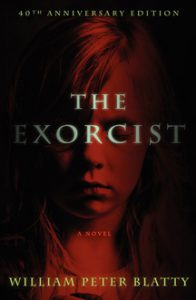In this series, I look back at past entries in the “Exorcist” saga as we await word of the renewal or cancellation of the Fox TV series that continues the movie saga into modern day.
I was inspired by last fall’s “Exorcist” TV series to look back at early material in the franchise. First up, of course, is “The Exorcist” novel (1971) by William Peter Blatty, who died in January at age 89 shortly after the TV series wrapped its first season. I had read this book before, on an “Exorcist” kick for the 2000 theatrical re-release, but remembered only that it was a good read. From the library I picked up the 40th anniversary edition (2011), which includes new material, but I’m not familiar enough with the original to notice the differences. (The web tells me Father Karras’ dream sequence is the most notable new scene. Most of the 40 additional pages of material comes from added dialog for the sake of pacing. Blatty never got a chance to write a second draft of the original publication, and he always felt it could use a polish.)
Being an atheist, I would presumably not be interested in religious-themed horror; however, I’ve always enjoyed this genre. One doesn’t have to be a believer to find that real-world religious mythology and iconography add heft to the proceedings. I can see why “The Exorcist” would be a moving book for Christians. At the same time, it has to rank on the short list of widely popular books among secular audiences that centrally deal with religious faith.
The title character is Father Merrin, a veteran exorcist who has previously faced the demon Pazuzu (who comes from real-world mythology). Merrin is in the opening chapters – he finds a Pazuzu icon buried in Iraq and knows the demon has returned – and at the end, when he performs the exorcism on 12-year-old Regan MacNeil in Washington, D.C. I wouldn’t have minded following this Obi-Wan Kenobi type into prequel stories (Blatty’s saga expands in “Legion,” but that’s a sequel). Here, we find him when he has just figured out how to resolve his waning faith – doing good deeds for people who repulse him is all that God asks, he decides.
We spend most of our time with Father Karras, who is in the midst of his struggle of faith. (A case could be made that Karras is the title character.) He’s particularly racked with guilt about the death of his mother in a cockroach-infested apartment in New York. He had left that city to pursue his career as a Jesuit psychiatrist. No doubt a nod to the book, the older priest in TV’s “Exorcist” was also tortured by the death of his mom in squalid circumstances.
As he slowly but steadily delivers more evidence that the demon is taking over Regan’s body, Blatty simultaneously hits us with mounds of evidence and theories from the field of psychiatric science to the point where we’re almost convinced she’s NOT possessed. As such, “The Exorcist” functions as a medical mystery. All scientific theories are exhausted – from the mundane to the bizarre-but-documented – and only then does Karras work up a case he can present to the church, hoping they’ll approve an exorcism. Exorcisms are rare — and kept hush-hush, to avoid bad PR — but not so rare that an exorcist can’t be found somewhere in the world to perform the ritual.

The characters are exquisitely written. Because we know the loving, happy Regan from the early chapters, we feel the pain of her mother, Chris. As she steps away from her film career to focus on Regan’s health, she doesn’t seriously struggle over that choice; she will do whatever it takes to save her daughter. This clashes somewhat with the Chris we know from the TV series, someone the adult Regan despises for putting career ahead of family.
Detective Kinderman appears disorganized but is savvy and thoughtful on the inside; coincidentally, “Columbo” made its TV debut the same year this book came out. He’s also endearingly lonely, asking Father Karras to the movies. Unlike “Psycho” author Robert Bloch, Blatty would go on to be involved in the film franchise spun off from his novel, starting with the 1973 movie’s screenplay, and his love of cinema is clear with so many characters having movie careers or being film lovers.
Burke Dennings is Chris’ director on a film shot within walking distance of her house; often drunk and rude, he’s one of those guys who can get away with it because he’s just Dennings being Dennings. He also serves as a stark personality for the demon to mimic when he takes over Regan’s body. We get a good bit of family drama between Chris’ housekeepers, husband-and-wife Karl and Willie, which also provides a red herring for Kinderman to pursue.
And Chris’ secretary Sharon rounds out the crew at the MacNeil household. If your daughter is gonna be possessed by a demon, you couldn’t ask for a better support group than Chris has. Karl often sits by Regan’s bedside – increasingly farther from the bed as the symptoms get worse (and the room becomes freezing and foul-smelling) – and Sharon is always ready to run to the pharmacist for medications.
I love the sense of time and place in “The Exorcist,” in 1971 in D.C. Kinderman and Karras in particular live in a world that’s on the verge of going cold, with people gradually becoming withdrawn and rude. Blatty’s particular interest in the profligation of drugs in big cities comes through in Karl’s arc, as he sneaks away to give cash to his addicted, wasting-away daughter. The iconic scene of Merrin looking up at the house while standing under a streetlamp in the rain is a visual indication of the book’s mood; it’s well-known from the movie posters, and the TV series also riffs on it.
The house itself is almost as much of a character as Bloch’s Bates Motel and house on the hill. It’s situated on a street that runs along the edge of a dropoff; the next street over is accessible to pedestrians by steep stairs. Regan’s room is on the top floor, with a large window that would lead to a deadly drop if someone were to tumble out. Regan’s playroom is in the basement; her games of Oija with Captain Howdy (who pops up again in the TV series) may have given Pazuzu a foothold.
Karras lives nearby in a dorm room of Georgetown University, the religious school where he teaches (It’s also Blatty’s alma mater). It’s interesting to note the contrast between Karras and Chris. He lives an ascetic life with few possessions and friends; she rents a nice house with servants at her beck and call, and she can take off time from her film career without being in immediate financial straits. But all of that is superficial when it comes right down to it: Karras is tormented by his mother’s death in squalor, Chris is tormented by Regan’s condition.
That having been said, this is not a book of torment. Regan’s decline happens so gradually that most of the book feels warm and homey, featuring conversations over tea and sandwiches, or a shared pot of coffee while leaning against the kitchen counter. There’s even a party — which is memorably capped by the book’s equivalent of the famous spider-walk sequence. Chris is certainly stressed, but I didn’t feel tense reading the book; instead, I was engrossed in the details of the medical science and the history of possessions and exorcisms. (Indeed, both Father Merrin and Regan’s case are based on real-world examples.)
Granted, this might be because I know how the story ends; readers in 1971 might have found the proceedings tenser. Also of an odd note, “The Exorcist” didn’t strike me as scary on this read; indeed, I often found the demon’s antics – classics such as the green vomit make their debut here, along with some behavior and dialog that’s too sexually graphic for the movies or TV show – to be amusing. Because Chris’ and Karras’ research into demon possession parallels the proceedings, there’s a sense of safeness to what’s happening, because they are working to figure things out.
“The Exorcist” isn’t enough to convert me to Christianity, but I enjoyed visiting its world. And besides, the MacNeils are atheists, so it’s not like I didn’t have a surrogate. Religious folks often hand apologetics books to nonbelievers – “The Case for Christ,” recently adapted to film, is a popular choice – but you really can’t do better than “The Exorcist” for a beautiful story of two men regaining their faith in the most challenging of circumstances.

